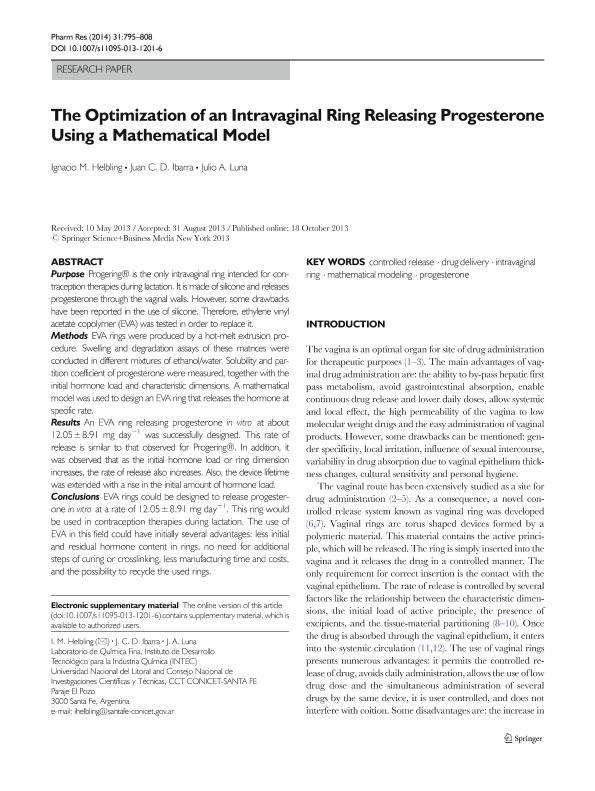Mostrar el registro sencillo del ítem
dc.contributor.author
Helbling, Ignacio Marcelo

dc.contributor.author
Ibarra, Juan Carlos Daniel

dc.contributor.author
Luna, Julio Alberto

dc.date.available
2016-12-13T14:46:15Z
dc.date.issued
2014-03
dc.identifier.citation
Helbling, Ignacio Marcelo; Ibarra, Juan Carlos Daniel; Luna, Julio Alberto; The optimization of an intravaginal ring releasing progesterone using a mathematical model; Springer/plenum Publishers; Pharmaceutical Research; 31; 3; 3-2014; 795-808
dc.identifier.issn
0724-8741
dc.identifier.uri
http://hdl.handle.net/11336/9253
dc.description.abstract
Purpose Progering® is the only intravaginal ring intended for contraception therapies during lactation. It is made of silicone and releases progesterone through the vaginal walls. However, some drawbacks have been reported in the use of silicone. Therefore, ethylene vinyl acetate copolymer (EVA) was tested in order to replace it. Methods EVA rings were produced by a hot-melt extrusion procedure. Swelling and degradation assays of these matrices were conducted in different mixtures of ethanol/water. Solubility and partition coefficient of progesterone were measured, together with the initial hormone load and characteristic dimensions. A mathematical model was used to design an EVA ring that releases the hormone at specific rate. Results An EVA ring releasing progesterone in vitro at about 12.05±8.91 mg day-1 was successfully designed. This rate of release is similar to that observed for Progering®. In addition, it was observed that as the initial hormone load or ring dimension increases, the rate of release also increases. Also, the device lifetime was extended with a rise in the initial amount of hormone load. Conclusions EVA rings could be designed to release progesterone in vitro at a rate of 12.05±8.91 mg day-1. This ring would be used in contraception therapies during lactation. The use of EVA in this field could have initially several advantages: less initial and residual hormone content in rings, no need for additional steps of curing or crosslinking, less manufacturing time and costs, and the possibility to recycle the used rings.
dc.format
application/pdf
dc.language.iso
eng
dc.publisher
Springer/plenum Publishers

dc.rights
info:eu-repo/semantics/openAccess
dc.rights.uri
https://creativecommons.org/licenses/by-nc-sa/2.5/ar/
dc.subject
Controlled Release
dc.subject
Drug Delivery
dc.subject
Intravaginal Ring
dc.subject
Mathematical Modeling
dc.subject
Progesterone
dc.subject.classification
Matemática Aplicada

dc.subject.classification
Matemáticas

dc.subject.classification
CIENCIAS NATURALES Y EXACTAS

dc.title
The optimization of an intravaginal ring releasing progesterone using a mathematical model
dc.type
info:eu-repo/semantics/article
dc.type
info:ar-repo/semantics/artículo
dc.type
info:eu-repo/semantics/publishedVersion
dc.date.updated
2016-12-12T13:45:43Z
dc.journal.volume
31
dc.journal.number
3
dc.journal.pagination
795-808
dc.journal.pais
Estados Unidos

dc.journal.ciudad
Nueva York
dc.description.fil
Fil: Helbling, Ignacio Marcelo. Consejo Nacional de Investigaciones Científicas y Técnicas. Centro Científico Tecnológico Santa Fe. Instituto de Desarrollo Tecnológico Para la Industria Química (i); Argentina
dc.description.fil
Fil: Ibarra, Juan Carlos Daniel. Consejo Nacional de Investigaciones Científicas y Técnicas. Centro Científico Tecnológico Santa Fe. Instituto de Desarrollo Tecnológico Para la Industria Química (i); Argentina
dc.description.fil
Fil: Luna, Julio Alberto. Consejo Nacional de Investigaciones Científicas y Técnicas. Centro Científico Tecnológico Santa Fe. Instituto de Desarrollo Tecnológico Para la Industria Química (i); Argentina
dc.journal.title
Pharmaceutical Research

dc.relation.alternativeid
info:eu-repo/semantics/altIdentifier/url/http://link.springer.com/article/10.1007/s11095-013-1201-6?no-access=true
dc.relation.alternativeid
info:eu-repo/semantics/altIdentifier/doi/http://dx.doi.org/10.1007/s11095-013-1201-6
Archivos asociados
